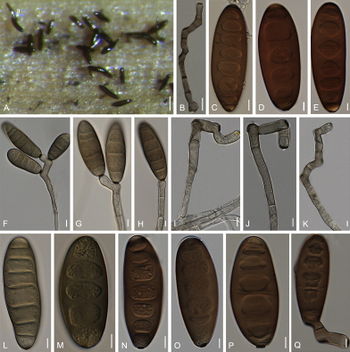Bipolaris sorokiniana
| Literature database |
|---|
| 396 articles sorted by: |
| • year (descending) |
| • research topics |
| • countries/regions |
| • host plants |
| • list of antagonists |

Author(s): D.S. Manamgoda, A.Y. Rossman, L.A. Castlebury, P.W. Crous, H. Madrid, E. Chukeatirote and K.D. Hyde
Source: Studies in Mycology, 2014, 79, p. 269
Bipolaris sorokiniana (Sorokin) Shoemaker 1959
The fungus is wide-spread and causes spot blotch on wheat and various other diseases on barley, other cereals and other crops. These can result in substantial crop and yield losses. Especially spot blotch on wheat is important in warmer and humid regions. Yield losses of up to 30% have been reported. The symptoms of spot blotch include brown spots, 1-2 cm large, with diffuse margins on the leaves of cereals.
Root rot or seedling blight are also often serious diseases. The fungus is seed-borne or it spreads through the air via conidia. For control resistant cultivars and pathogen-free seeds are used.
| Vernacular names | |
|---|---|
| • Deutsch: | Braunfleckenkrankheit |
| • English: | kernel black point spot blotch |
| • Español: | helmintosporiosis de cereales |
| • Français: | maladie des taches helminthosporiennes |
The conidia are oval-shaped, brown with rounded ends and 5-10 septations. They measure around 60-100 µm in length and about 20 µm in width. The sexual stage is rare and the ascospores are filamentous and have a size of 200-300 x 5-10 µm.
Synonyms:
Bipolaris multiformis
Cochliobolus sativus
Drechslera multiformis
Drechslera sorokiniana
Helminthosporium sativum
For details see the respective page in Wikipedia.
- Other images of Bipolaris sorokiniana (IPM Images - click to enlarge)


